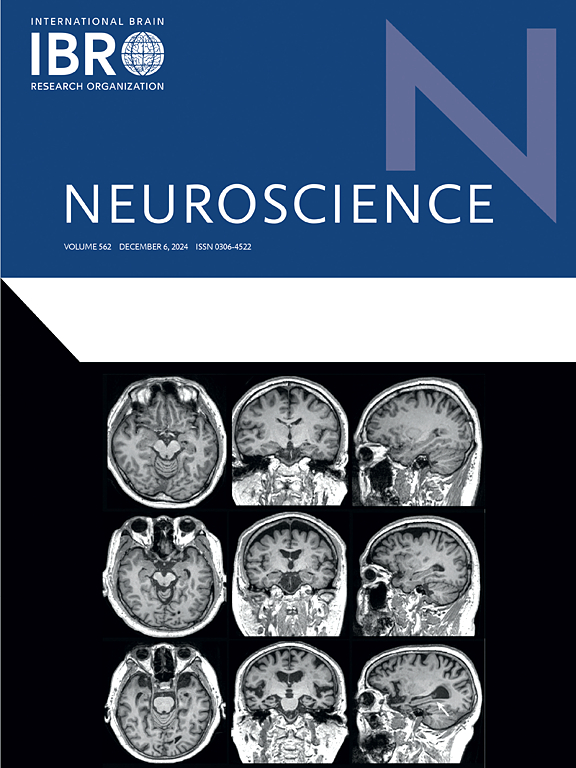积雪草通过抑制神经炎症对LPS/淀粉样蛋白诱导的神经退行性变的神经保护作用
IF 2.9
3区 医学
Q2 NEUROSCIENCES
引用次数: 0
摘要
蛋白质聚集和小胶质细胞介导的神经炎症是神经退行性疾病进展的主要因素。目前,可用的治疗神经退行性疾病的药物疗效有限,并伴有几种副作用;这表明需要发现新的治疗药物。因此,我们的目的是通过人类小胶质细胞和神经元细胞模型来评估亚洲花楸对β淀粉样蛋白(Aβ)和脂多糖(LPS)诱导的神经退行性变的神经保护作用。为了确定亚洲曲的潜在分子靶点,采用基于网络药理学的方法和分子对接,然后通过间接ELISA、Western blotting和间接免疫荧光分析进行实验验证。我们通过网络药理学、分子对接和基于细胞的模型研究结果表明,AKT1、TNF-α、STAT3、CASP3、PTGS2、MAPK1、APP和NF-κB是asiatica的潜在分子靶点。此外,我们还发现,在小胶质细胞和神经元细胞中,积雪草治疗可减少LPS/ a β诱导的细胞死亡、NO生成和LDH释放。通过降低LPS、Aβ和LPS+Aβ诱导的神经炎症标志物,进一步观察积雪草的抗神经炎症作用;小胶质细胞中的TNF-α、il - 6、IL-1β、AKT1、INOS、NF-κB、MAPK3和PTGS2。此外,神经退行性和凋亡标志物;APP、α-syn、P-tau、STAT3、CASP3均在积雪草处理后降低,提示积雪草具有神经保护作用。我们首次证明了亚洲麻风通过抑制神经炎症和神经退行性标志物,对LPS、Aβ和LPS+Aβ−诱导的神经退行性变性具有神经保护作用。研究结果表明,亚洲弓形虫可能是神经炎症介导的神经退行性疾病,如帕金森病和阿尔茨海默病的有希望的候选者。本文章由计算机程序翻译,如有差异,请以英文原文为准。

Neuroprotective effects of Centella asiatica against LPS/amyloid beta-induced neurodegeneration through inhibition of neuroinflammation
Protein aggregation and microglia-mediated neuroinflammation are the major contributors to the progression of neurodegeneration. Currently, available drugs for neurodegenerative diseases have limited efficacy and are associated with several side effects; suggesting a need to discover novel therapeutic agents. Therefore, we aim to evaluate the neuroprotective effects of C. asiatica against amyloid beta (Aβ) and lipopolysaccharides (LPS)-induced neurodegeneration using human microglia and neuronal cell-based models. To identify potential molecular targets of C. asiatica, network pharmacology-based approaches were used along with molecular docking, followed by experimental validation via indirect ELISA, Western blotting, and indirect immunofluorescence assays. Our results from network pharmacology, molecular docking, and cell-based models, exhibited that AKT1, TNF-α, STAT3, CASP3, PTGS2, MAPK1, APP, and NF-κB are the potential molecular targets of C. asiatica. Further, we have found that C. asiatica treatment reduces LPS/Aβ-induced cell death, NO production, and LDH release in microglia and neuronal cells. The anti-neuroinflammatory effect of C. asiatica was further observed via the reduction of LPS, Aβ, and LPS+Aβ-induced neuroinflammatory markers; TNF-α, IL6, IL-1β, AKT1, INOS, NF-κB, MAPK3, and PTGS2 in microglia cells. Moreover, neurodegenerative and apoptotic markers; APP, α-syn, P-tau STAT3, and CASP3 were reduced upon C. asiatica treatment in neuronal cells, suggesting its neuroprotective properties. For the first time, we have shown the neuroprotective effects of C. asiatica against LPS, Aβ, and LPS+Aβ −induced neurodegeneration via inhibition of neuroinflammation and neurodegenerative markers. The outcomes of the study suggested that C. asiatica could be a promising candidate for neuroinflammation-mediated neurodegenerative diseases like Parkinson’s and Alzheimer’s.
求助全文
通过发布文献求助,成功后即可免费获取论文全文。
去求助
来源期刊

Neuroscience
医学-神经科学
CiteScore
6.20
自引率
0.00%
发文量
394
审稿时长
52 days
期刊介绍:
Neuroscience publishes papers describing the results of original research on any aspect of the scientific study of the nervous system. Any paper, however short, will be considered for publication provided that it reports significant, new and carefully confirmed findings with full experimental details.
 求助内容:
求助内容: 应助结果提醒方式:
应助结果提醒方式:


